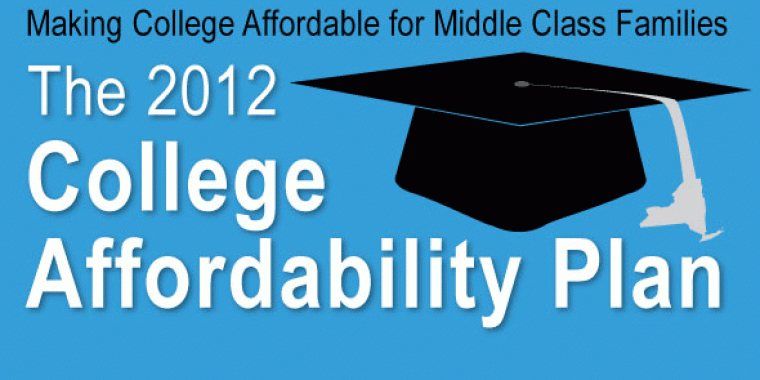
Senator Flanagan Joins With Colleagues To Help Make College More Affordable
John J. Flanagan
May 21, 2012
-
ISSUE:
- Higher Education

Senator John Flanagan (2nd Senate District) joined with Majority Leader Dean G. Skelos and the other members of the Senate Majority Conference to announce a plan that will help middle-class families and students afford the rapidly increasing cost of a college education. The Senate’s 2012 College Affordability Plan would help parents save for higher education for their children and give students and families access to low interest student loans, as well as clear information about the size of the loan debt they are taking on.
In addition, the plan would encourage young New Yorkers to stay in the Empire State to begin their careers by creating a new “Stay-In-New York” tax credit. This would provide up to $12,000 in tax relief over four years for students who graduate on time or early from a college in New York, perform community service work and stay and work in New York for at least four years.
“Achieving a college degree should be a reasonable and attainable goal for everyone and this plan will help provide many of our best and brightest with the ability to accomplish that. It will help provide middle class families across our state with a better ability to help their children succeed while also making it easier for those young people to stay in New York. And while the obvious benefit will be to the families and students, the reality is that it will be a great investment in our state’s collective future,” stated Senator Flanagan.
The Senate’s 2012 College Affordability Plan would help middle class families address the enormous financial burden that higher education places on them and on young students through the following:
Double Existing Tuition Tax Credits and Deductions
In 2001, Senate Republicans proposed and enacted the first state tuition tax credit to help middle class families afford higher education. Since then, the cost of a college education has risen by 40 percent and effectively eroded the benefit of the tuition tax credits and deductions. This proposal would immediately double the size of existing tuition tax credits and deductions and index them to the Higher Education Price Index (HEPI) to keep pace with rising costs.
• The current tax deduction would increase from $10,000 to $20,000.
• The maximum tax credit would increase from $400 to $800.
• A new “Stay-in-New-York” tax credit would provide additional relief of up to $12,000 over 4 years (up to $3,000 per year) for individuals who: graduate from a New York college or university in 4 years or less; meet a community service requirement; and who stay and work in New York State for at least 4 years after graduation. (When combined with existing credits, graduates would be eligible for up to $15,200 in total tax relief.)
• In future years, to ensure that the tax credits would continue to be effective, the plan would also link these credits and deductions to the Higher Education Price Index (HEPI), to ensure that these tax benefits are not lost due to inflationary pressures.
Cut Student Loan Interest Rates in Half
The plan establishes a new $100 million Linked Deposit Student Loan Program that would make new low interest loans available to middle class families. Financed through a new public-private partnership between lending institutions and the State’s Short Term Investment Pool (STIP), the program would provide loans of up to $7,500 at rates two to three percentage points below the typical rates offered by a bank and reduce interest rates by up to 50 percent.
Allow Tuition Pre-Payment
The plan would help parents save thousands of dollars in future tuition costs by enabling them to pre-pay for their children’s college education at SUNY and CUNY schools.
Empowering Consumers – Truth in Lending
The plan would designate the newly-created Department of Financial Services as an official “Truth-In-Lending” clearinghouse for information related to college affordability. It would require the department (which already has extensive interaction with financial institutions) to establish a “one stop shop” for consumers to obtain easy-to-use, reliable information on college loans and interest rates.
This would help parents and students navigate the often confusing world of student loans and higher education financing so that they can find the best, most affordable way to finance a college education.
It would also require colleges and universities to provide additional financial information to parents and prospective students, including clearly outlined, easy-to-understand explanations of the debt burden a family (or graduate) would face depending on the loan they secure. Information would include the amount of monthly payments, interest rates, and total dollar amount of interest to be paid among other items.
Information from The Project on Student Debt (annual surveys conducted by U.S. News & World Report, the College Board and Peterson’s College Guide), illustrate the financial problems created by rising tuition costs and the debt owed to pay off those costs.
In 2010, graduates from colleges in New York had an average loan debt of $26, 271, the 10th highest amount in the country. Just six years ago in 2005-06, the average loan for New York schools was $19,249 and New York ranked 20th in the nation. Sixty-one percent of students who attend college in New York have college loan debts.
Nationally, college tuitions have increased well beyond the rate of inflation, income and health care costs. It’s estimated that by 2016, the average cost of a public college will have more than doubled in 15 years. The amount of student debt is now more than one trillion dollars, surpassing the amount owed on credit cards and auto loans.
“Today the State Senate is clearly standing up for student aid with a creative mix of proposals that will help families with college expenses,” said Laura L. Anglin, President of the Commission on Independent Colleges and Universities, a statewide association for more than 100 private, not-for-profit campuses. “Our new college graduates have just spent several years getting to know their adopted towns, cities and neighborhoods. With these timely proposals, particularly the ‘Stay-In-New-York’ incentive, we are closer to the goal of encouraging more of our college-educated talent to remain in New York following graduation. We thank the Senate for supporting our students and their families as they seek to make their college dream a reality.”
Share this Article or Press Release
Newsroom
Go to NewsroomStatement from Senate Republican Leader Flanagan Regarding NRSP Graffiti
February 11, 2019


Senator Flanagan Joins Long Island Cares To Protect Local Pets
February 6, 2019

